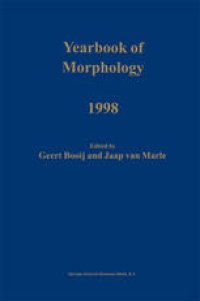
Ebook: Yearbook of Morphology 1998
- Tags: Theoretical Languages, Psycholinguistics, Semantics, Syntax, Phonology
- Series: Yearbook of Morphology
- Year: 1999
- Publisher: Springer Netherlands
- Edition: 1
- Language: English
- pdf
A revival of interest in morphology has occurred during recent years. The Yearbook of Morphology series, published since 1988, has proven to be an eminent support for this upswing of morphological research, since it contains articles on topics which are central in the current theoretical debates which are frequently referred to.
The Yearbook of Morphology 1998 focuses on two issues: the position of inflection in the grammar, and the interaction of morphology with phonology, in particular the problem of allomorphy. In addition, this volume presents a study of the relation between transposition and argument structure, a declarative model of word formation applied to conversion in German, an analysis of Dutch verbal compounds and a study of the semantic aspects of nominalization. The relevant evidence comes from a wide variety of languages.
Theoretical, descriptive, and historical linguists, morphologists, phonologists, and psycholinguists will find this book of interest.
A revival of interest in morphology has occurred during recent years. The Yearbook of Morphology series, published since 1988, has proven to be an eminent support for this upswing of morphological research, since it contains articles on topics which are central in the current theoretical debates which are frequently referred to.
The Yearbook of Morphology 1998 focuses on two issues: the position of inflection in the grammar, and the interaction of morphology with phonology, in particular the problem of allomorphy. In addition, this volume presents a study of the relation between transposition and argument structure, a declarative model of word formation applied to conversion in German, an analysis of Dutch verbal compounds and a study of the semantic aspects of nominalization. The relevant evidence comes from a wide variety of languages.
Theoretical, descriptive, and historical linguists, morphologists, phonologists, and psycholinguists will find this book of interest.